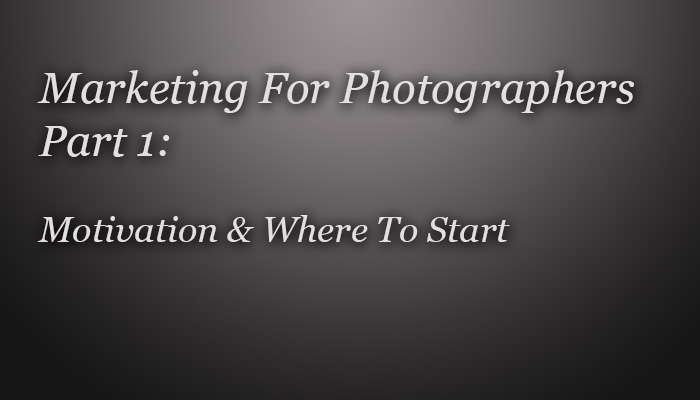A Guide To Marketing For Photographers – Part 1, Motivation & Where To Begin
This was initially going to be a large series of articles on marketing for photographers. However, since posting this on various social media platforms, this topic has received the lowest number of click-throughs (number of people interested in the topic and clicked through from facebook, google+ etc.) of any article written on Shutter…Evolve. It seems this topic isn’t currently appealing to most of our audience. One part of good marketing is listening to what your audience wants. So for the time being, this series will be put on hold.
We are starting this Marketing for Photographers series, not with an explanation of marketing and how to apply marketing techniques to your photography, but with what I believe are the main predictors of success in any form of life: Attitude and Motivation.
Some photographers look for the quick-fix, the quick technique that will get them a huge following, the one-button solution that will create stunning images in a flash. But once the promises of Get Rich Quick schemes fade away, we see their motivation and enthusiasm drain with them.
I love my job. Every day I thank my lucky stars that I do this for a living. Yet I know luck had nothing to do with it. Years of planning, perseverance, the desire to improve constantly and the belief in myself have gotten me to this point. And I firmly believe anyone can do the same, if they so wish.
Beliefs and Attitudes
Message to the cynics
If you’re a cynic and don’t believe there’s money in photography, stop reading now. This article won’t help you. You’ve chosen the answer that suits you, and let that decision serve you well in the future. But please don’t try to pass that cynicism onto others. Everyone has a right to seek out their dreams even if it didn’t work for you.
Becoming a cynic is easy. It is far easier, for example, to say there is no money in photography and not bother trying than to dedicate your life, day-in day-out, to making photography your career. It is far easier to blame external processes when we fail, than to accept the failure as our own.
An example of taking responsibility
Let me give you an example. I have a course on digital blending with Luminosity Masks. 14 months ago I created this course, and published the sales page on the internet. Initially this page was on my blog, ThroughStrangeLenses.com. My goal was to get my sales page on the first page of google if you search for the terms ‘Luminosity Mask Tutorial’.
I failed miserably. After months and months of trying, my Luminosity Mask course wasn’t even in the top 100 searches. I felt like I was swimming against a tide that was getting stronger all the time. Almost all of my sales were through word-of-mouth on social networks. However, I never stopped taking responsibility for this lack of success with google. I was doing something wrong and I had to change my behaviour.
Now, being a blogger for over 5 years, I have a lot blogger friends, most of whom have been in the same situation as me. Instead of admitting that they’re doing something wrong, many will blame google processes for not ranking them as well as they think they deserve to be. It’s a conspiracy.
I’ve seen a lot of bloggers come and go in those 5 years. The ones that are still around have a far more proactive attitude.
In my case, it took a year of getting nowhere before I had to make a decision. It wasn’t just my Digital Blending course that was doing poorly in google, most of my site was. Imagine that! Working on a site for over a year, almost every day, and getting virtually nowhere in google! The problem, I judged after some research, was that google struggled to classify my site. Was it a travel blog? Was it a lifestyle bog, since I wrote about meditation and minimalism? Was it a personal photography blog? Was it a photography education site?
I made the decision to split my site into 3 parts: ThroughStrangeLenses.com for my personal photography and travels; DharmaChimp.com for meditation and minimalism; ShutterEvolve.com for photography education. I hoped that this would make it easier for google to know where my sites fit in their searches.
I moved all of my courses onto ShutterEvolve.com and began, once more, to push my Luminosity Mask course up google’s search ranking. This was a big risk. Google likes older sites. The older the site, the less likely it’ll be a spam trap. I was moving my products from an older, more respected site, to a new site with zero recognition from google.
Nevertheless, I took responsibility and worked hard. As of today, not only is my Luminosity Mask course on the first page for the search term ‘luminosity mask tutorial’ (6th place currently), I have an article just below it, and two more tutorials on the next page, all of which generate important traffic. This could change any time if google decides to change its algorithm, but that’s a challenge you face with internet marketing.
It could have been so much easier for me to simply give up and blame google at any point. The question I’d like to ask is how many people would have given up after a year of nothing?
Marketing Books and Self Study
In the last 4 months I’ve read 8 books on marketing. I haven’t skimmed these books. I’ve read them, front to back, and taken notes throughout. I’ve looked at every note I’ve taken and asked myself how I could apply this to my business. I set aside afternoon sessions every week, where I can sit without interruption and brainstorm marketing ideas. Since marketing influences everything, you have to devote a large amount of time to your understanding and application of it.
In the coming articles, I’m going to talk about what I’ve learned from these books and how I’ve applied those learnings to my own business. But I highly recommend you go out and purchase some well-reviewed marketing books for your own use.
Below I’ve included links to the 8 books I’ve read recently and happily recommend. Here’s an interesting thought – how many readers of this article do you think will buy (if they can afford it) one of these books, or similar marketing books? How many do you think will have the motivation to read that book fully, and take notes? How many of these people will use what they’ve learned from that book to create a stronger marketing plan?
I’m sure by now you’re thinking of a small-ish percentage, given how prevalent procrastination is in modern day society. However, with this in mind, how many do you think will be motivated enough to read all 8 books, take notes, and use what they have learned to the best of their ability? According to research most people wouldn’t have even made it this far in this article, so I suspect close to zero will have the motivation to read all 8 books.
The point I’m trying to make is not that these books will guarantee success – they don’t – but that very few people will go above and beyond what is required to achieve their dreams. Most want instant results without the hard work – that is why the Get Rich Quick market is still going strongly. But when the money doesn’t come in as quickly as they hoped, their motivation dwindles to nothing.
It is up to you be an outlier, that person who stands beyond the rest, willing to work intelligently and take responsibility for your successes and failures.
Recommended Books
Disclaimer: I’m an Amazon affiliate which means if you click on the links below and buy the book, I get around 4%-5% commission. This doesn’t affect your payment, Amazon pays me. We will talk more about how you can benefit from affiliate programs in later articles. However, you are under no obligation to purchase these books of course. They are simply resources I’ve had great pleasure in learning from. There are many books out there that I’m sure will be of great value to you.
The Ultimate Small Business Marketing Book, by Dee Blick
500 Social Media Marketing Tips, by Andrew Macarthy
Contagious: Why Things Catch On, by Jonah Berger
Digital Minds, by WSI
Stealth Marketing, by Jay Abrahams
Email Persuasion: Captivate and Engage Your Audience, by Ian Brodie
Write To Sell, by Andy Maslen
49 Quick Ways To Market Your Business For Free, by Sarah-Jane White
Where to Start?
This may be the most difficult place for some readers. Here you have to face some home truths: if you’re posting your images on facebook, flickr, forums etc. and they’re not getting an exciting response, your images probably aren’t good enough for your target audience.
We all have to face this fact. At first, when all of our friends and family tell us how great our images are, we tend to believe them. These compliments, although coming from a good place, may blind us to the true quality of our images. Your career in photography is fundamentally built on the quality of your images – if you choose not to improve, you lessen your chances of building a strong career.
I am my own worst critic. I look for fault in every image I’ve ever published. Once, I was on a train going from London to Newcastle after a trip to Jordan. I was looking through my portfolio on my iPad, spending a couple of minutes on each photo.
The girl sitting next to me saw what I was doing and asked if they were my photos. After I said yes, she asked why I was looking through them. She thought I was just admiring my own work. I explained that I was looking for weaknesses in each photo, and asking myself how to improve them. She looked through them and said she didn’t think they needed improving. It was a lovely compliment coming from a genuine place, but it wouldn’t help me in improving myself as a photographer. Compliments are great, as long as you don’t let them blind you.
In my never-ending quest for improvement, I wrote an article over a year ago critiquing one of my very first photos, and talking about how I would improve upon it. I posted an image which I considered to be an improvement, to show how I’d developed since then. Looking at that newer image, there’s a whole list of improvements to be made. In fact, I wouldn’t even publish it nowadays. Here’s the article: Analyzing Bad HDR.
So the very first starting point is ‘Do my images stand out in terms of quality in my target market?’ (Actually, knowing your target audience is the starting point but that requires its own article) When I say target market, I’m talking about the market within which you plan to build your career. You don’t have to compare your images to the best on 500px, if your plan is to sell specialized prints of your local area to local residents. You have to compare the quality of your images with those who you are competing against for customers.
Do not be afraid to invest in development. You’ve paid $1,000s in camera equipment, spending a couple of hundred dollars on learning to create stunning images with that equipment is the next wisest investment. I’ve lost count of how much I’ve spent on subscriptions, photography books and courses. My philosophy is, how can I maintain a successful career if I’m not willing to invest in it? However, don’t think you have to spend money to improve. Sites like Youtube are full of incredible free tutorials. The challenge is finding them. But it is certainly worth the time investment in the long run.
My advice is, find your favourite photographer and consume all you can from him/her. If you have to pay for workshops, do it. Because I guarantee other people competing in your market are attending these workshops.
Look for other photographers from which to learn. Never stop expanding your knowledge. Never consider yourself a master. You’ll soon find that as the quality of your imagery increases, so will the attention you receive. Then, once you’re ready, you can begin the marketing process.
Now we have covered the fundamentals, the next articles will talk more about the How-To of marketing. But without the motivation and mindset to work hard and improve, the following articles are meaningless. That is why I have devoted so much space to these topics here.
Want photography articles straight to your Newsfeed? Follow me on facebook for instant updates: Jimmy McIntyre
Topics to come in this marketing series…
What is Marketing and How Can You Use It?
Who Is Your Target Audience?
How To Get More Followers On Facebook
How To Find New Audiences
Marketing Without Social Networks
Managing Your Brand Effectively
An Example Of An Effective Marketing Strategy
And More….
Every Sunday I send our email subscribers a weekly photography round-up. If you wish to receive these marketing articles to your email so you don’t miss any, feel free to signup below. You’ll also receive our free Easy Panel.








